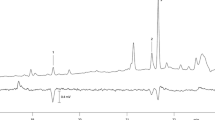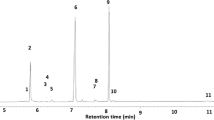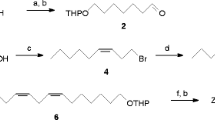Abstract
The honey locust gall midge, Dasineura gleditchiae Osten Sacken 1866 (Diptera: Cecidomyiidae) is the main pest of ornamental varieties of the honey locust tree, Gleditsia triacanthos L., in North America, and is now becoming a pest of concern in Europe. Female midges were observed to emerge in the early morning with their ovipositor extended until they mated. Volatiles were collected from virgin females in a closed-loop stripping apparatus and analyzed by gas chromatography (GC) coupled to electroantennographic (EAG) recording from the antenna of a male midge. A single EAG response was observed, which was assumed to be to the major component of the female sex pheromone. This was identified as (Z)-2-acetoxy-8-heptadecene by comparison of its mass spectrum and GC retention times on different columns with those of synthetic standards and by micro-analytical reactions. This compound was synthesized, and the individual enantiomers were produced by kinetic resolution with lipase from Candida antarctica. Analysis of the naturally-produced compound on a cyclodextrin GC column indicated it was the (R)-enantiomer. In EAG dose-response measurements, the (R)-enantiomer alone or in the racemic mixture evoked significant responses from the antennae of male D. gleditchiae, whereas the (S)-enantiomer did not. In field trapping tests, the (R)-enantiomer attracted male D. gleditchiae. The racemic compound was equally attractive, but the (S)-enantiomer was not attractive. Both the pure (R)-enantiomer or racemic (Z)-2-acetoxy-8-heptadecene, applied to red rubber septa in a dose range of 3–30 μg, constitute a strongly attractive bait in sticky traps for monitoring the flight of D. gleditchiae.






Similar content being viewed by others
References
Amarawardana, L., Hall, D. R., and Cross, J. V. 2006. Investigations on the sex pheromone of pear leaf midge, Dasineura pyri (Bouché), and other gall midge pests of fruit crops. Proceedings of IOBC Workshop on Arthropod Pest Problems in Pome Fruit, Lleida, Spain, 4-6 September 2006.
Beadle, G. W,. and Ephrussi, B. 1936. A technique of transplantation for Drosophila. Am. Nat. 70: 218–225.
Bolchi, S. G., and Volonte, L. 1985. Dasineura gleditchiae Osten Sacken, a gall midge new to Italy (Dipera, Cecidomyiidae). Bollettino Zoologia Agraria e di Bachicoltura 18: 185-189.
Corey, E. J., and Suggs, J. W. 1975. Pyridinium chlorochromate. An efficient reagent for oxidation of primary and secondary alcohols to carbonyl compounds. Tetrahedron Lett. 16: 2647-2650.
Cross, J. V., and Hall, D. R. 2005. Pheromones. Patent Cooperation Treaty PCT/GB2005/002504.
Fischer, S., and Pivot, D. 1992. Apparition en Suisse de la cecidomyie Dasineura gleditchiae O. S. (Diptera, Cecidomyiidae) ravageur du fivier commun Gleditsia triacanthos. L. Rev. Suisse de Viticulture, Arboriculture et Horticulture 24: 203-204.
Gries, R., Khaskin, G., Daroogheh, H., Mart, C., Karadag, S., Er, M. K., Britton, R., and Gries, G. 2006. (2S,12Z)-2-Acetoxy-12-heptadecene: major sex pheromone component of pistachio twig borer, Kermania pistaciella. J. Chem. Ecol. 32: 2667-2677.
Halstead, A. J. 1992. The 1991 Presidential address part 2. Some pests new to Britain in recent years. British J. Entomol. Nat. Hist. 5: 41-47.
Harris, M. O., and Foster, S. P. 1999. Gall midges, pp. 27-49 in: J. Hardie, A. L. Minks (eds.). Pheromones of Non-Lepidopteran Insects Associated with Agricultural Plants, CAB International, Oxford.
Hillbur, Y., Celander, M., Baur, R., Rauscher, S., Haftmann, J., Franke, S., and Francke, W. 2005. Identification of the sex pheromone of the swede midge. Contarinia nasturtii. J. Chem. Ecol. 31: 1807-1828.
Jorgenson, M. 1970. Preparation of ketones from the reaction of organolithium reagents with carboxylic acids. pp. 1-97, in R. Bittman, W.G Dauben, H. O. House, A. S. Kende, B. C McKusick, and J. Meinwald, (eds.). Organic Reactions 18: 1-97. Wiley, New York.
Leonhardt, B. A., and DeVilbiss, E. D. 1985. Separation and double-bond determination on nanogram quantities of aliphatic monounsaturated alcohols, aldehydes and carboxylic acid methyl esters. J. Chromatogr. 322: 484-490.
Liu, Y., He, X., Hall, D., Amarawardana, L., and Cross, J. 2007. (2S,8Z)-2-Butyroxy-8-heptadecene: major component of the female sex pheromone of a gall midge, Rhopalomyia spp., pest of chrysanthemums in China. Abstracts of 23th Meeting of International Society of Chemical Ecology, Jena, Germany, p 277.
Nijveldt, W. 1980. Niewe galmuggen voor de Niederlandse fauna. 7th Entomologische Berichten Amsterdam 40: 53-56.
Ripka, G. 1996. Damage of honey locust trees by Dasineura gladitchiae Osten Sacken (Dipera, Cecidomyiidae). Novenyvedelem (Plant Protection) 32: 529-532.
Simova-Tossic, D., and Skuhrava, M. 1995. The occurrence and biology of Dasineura gleditchiae O. S. (Dipera, Cecidomyiidae) in Serbia. Acta Soc. Zool. Bohem. 59: 121-126.
Skuhravá, M. 1997. Family Cecidomyiidae. pp. 71-204 in L. Papp, B. Darvas (eds.). Contributions to a Manual of Palearctic Diptera, vol. 2. Science Herald, Budapest.
Suckling, D. M., Walker, J. T. S., Shaw, P. W., Manning, L.-A., Lo, P., Wallis, R., Bell, V., Sandanayaka, W. R. M., Hall, D. R., Cross, J. V., and EL-Sayed, A. M. 2007. Trapping Dasinuera mali (Diptera: Cecidomyiidae) in apples. J. Econ. Entomol. 100: 745-751.
Thompson, P. B., Parrella, M. P., Murphy, B. C., and Flint, M. L. 1998. Life history and description of Dasineura gleditchiae (Diptera: Cecidomyiidae) in California. Pan-Pac. Entomol. 74: 85-98.
Xiao, L., and Kitazume, T. 1997. Optically active propargylic and allylic alcohols with a difluoromethyl group at the terminal carbon. Tetrahedron Asymm. 21: 3597-3601.
Zellner, B. d’A., Bicchi, C., Dugo, P. and Rubiolo, P. 2008. Linear retention indices in gas chromatographic analysis: a review. Flavour Fragr. J. 23:297-314.
Acknowledgements
This work was sponsored in part by a grant of NKFP 4/012/2004 and by a grant of the Hungarian Scientific Research Fund (OTKA) K 72767 to G. Szőcs. The GC-EAD apparatus was financed by GVOP-3.2.1-2004-04-0153/3.0 (major part) and by OTKA T37355 (minor part) to G. Szőcs. We are grateful to G. Gries for a sample of (2S,12Z)-2-acetoxy-12-heptadecene.
Author information
Authors and Affiliations
Corresponding author
Rights and permissions
About this article
Cite this article
Molnár, B., Kárpáti, Z., Szőcs, G. et al. Identification of Female-produced Sex Pheromone of the Honey Locust Gall Midge, Dasineura gleditchiae . J Chem Ecol 35, 706–714 (2009). https://doi.org/10.1007/s10886-009-9641-5
Received:
Revised:
Accepted:
Published:
Issue Date:
DOI: https://doi.org/10.1007/s10886-009-9641-5




